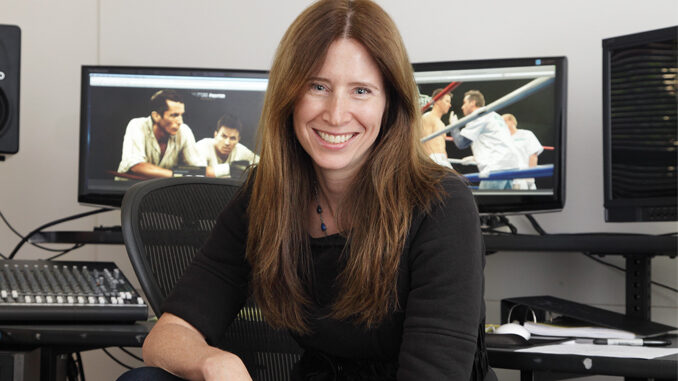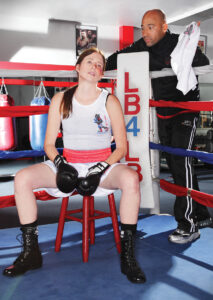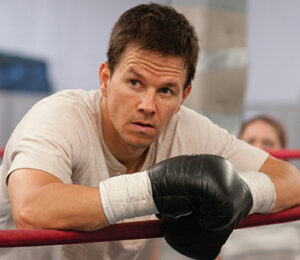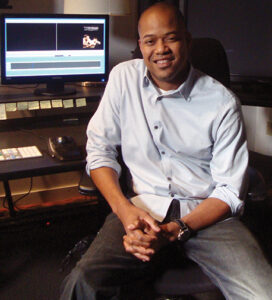
by Michael Goldman • portraits by Gregory Schwartz
If ever a single feature film illustrated the painstaking effort editors go through to bring disparate parts together to create a greater whole, David O. Russell’s The Fighter would be that film. The movie, after all, details the story of real-life boxer “Irish” Micky Ward (Mark Wahlberg), but it also tells the story of his troubled brother, Dicky Eklund (Christian Bale), their giant family (their mother, father, and seven sisters all play key roles), and a love story between Ward and his girlfriend Charlene (Amy Adams), among other story elements.
Simultaneously, The Fighter also pays loving visual homage to Ward’s working-class hometown where the action takes place (Lowell, Massachusetts), replicates elements of a real HBO documentary that featured Eklund in the 1990s as a framing device, incorporates archival video footage and painstakingly re-creates portions of Ward’s actual boxing matches as they were broadcast on HBO in the 1990s––right down to recording them using standard- definition video shot by actual HBO crews hired by film- makers.
For editor Pamela Martin, the project represents a reunion with Russell, for whom she edited Spanking the Monkey in 1994, the first feature film for both of them, but it’s also a major departure from the comedies she has done in recent years (Little Miss Sunshine, which earned her an ACE Eddie Award nomination; Youth in Revolt; among others). Piecing together crucial boxing sequences that had to resemble familiar, real-world events, navigating through over 70 hours of boxing footage and piecing it all together efficiently inside and around the movie’s main dramatic elements posed some of the biggest challenges of her career.
“It was tricky; a real balancing act,” Martin says of the experience. “Although it’s called The Fighter, the movie is actually about Micky and Dicky. Then, they have that massive family, and trying to balance all the characters and take our time with character development so that it will all pay off later in the movie was complicated. Probably, the hardest part of editing this film––aside from the climactic final fight [between Ward and British fighter Shea Neary], was the first act of the movie, especially the opening of the film. That’s when we let you know who these characters are—Micky is the fighter, but Dicky is also a fighter, a former boxer who has become a drug addict. He has his demons to fight.”

Those early scenes use re-creations of segments from the 1995 HBO documentary High on Crack Street to show Ward’s frustrations as he trains while his brother is preoccupied inside a crack house. They also show the brothers walking through the city of Lowell, adored by their fellow townspeople, which illustrates the gritty flavor of the town and the lead characters. Russell worked with Martin to design that walk as an early expository moment in the film.
“There were several things we were trying to plunge the movie into early—one of them was the streets of Lowell, the people there, the warmth and realness of it all, and how at home Micky and Dicky are there as road pavers [their day jobs] and as local heroes,” Russell explains. “We shot the opening walk through town in long sections of choreographed Steadicam shots, and in the editing room, we kept cutting it until we found the right rhythm, feel and pace.”
Technical Hurdles
In production, Russell and cinematographer Hoyte van Hoytema made two major decisions that had potential to impact the editorial process. The first was the decision to shoot the dramatic portions of the movie on Super-35mm 2- perf film stock, using brand new, small, lightweight Aaton Penelope cameras. The rare 2-perf choice was made to make shooting film more affordable while giving the movie the gritty aesthetic the director wanted. At the same time, it also allowed filmmakers to work largely hand- held with smaller than usual film cameras in a mobile and flexible way in often small, cramped spaces. Russell and van Hoytema say it saved them great time and expense during production.
But the decision did create the potential for additional post-production challenges, like digitally removing gate hair and dirt from the smaller original frames, since 2-perf involves exposing less negative overall. Indeed, there was some additional work that had to be done there, according to Martin and Terel Gibson, who was first assistant editor but was bumped up to additional editor during the show. But Gibson says the dust-busting work was done seamlessly, and thus posed no creative threat to the story choices made by Martin as she cut the movie.
“The dust-busting process is very advanced, and there was never a time when a creative decision had to be com- promised because of gate hair,” Gibson says. “Everything was fixable.”
On the other hand, the even more unorthodox decision to shoot the three main boxing matches in the movie not only in HBO’s original broadcast style, but actually using legacy Betacam-SP standard-definition video cameras, and an HBO production truck and personnel, did pose technical and creative issues. The old video cameras, after all, were capturing imagery at 30fps, filled with artifacts and anomalies that Russell wanted in terms of having them evoke the look of early 1990s era video, but sometimes leaving filmmakers with even more artifacts than they bargained for.
One problem was that the HBO cam- eras were turned on and off all day long during the three days of shooting boxing in Lowell, meaning that the sequences they captured were not slated. The second problem was the fact that original audio for those HBO cameras was not recorded at the correct frame rate the first couple of days, so Gibson says there was about 12 hours of boxing footage that had audio drift issues, and even more that had no slates.

The plan was to transfer the video to 24fps HDCAM-SR tape to make it a 24- frame Avid project cut at DNX36 HD resolution, 1920 x 1080, on Martin’s Avid Media Composer 3.1.3 system. But upon doing that, filmmakers realized the modern transfer process was introducing even more artifacts than they wanted onto the older format’s original imagery. That was fine for allowing Martin to cut pieces together, but those pieces then had to be upgraded to finish those sections of the movie.
“The idea was that the Digibetas would become sub-masters and then we would work from the new HDCAM-SR masters to finish the movie,” Gibson says. “But it picked up a lot of interlacing in the transfer, and that took the images beyond the standard-def, mid-‘90s look that Russell was looking for.”
The video shots were then transferred, cut for cut, pulling from the original Digibeta source material, and converted using a proprietary software process so that new 24fps files, without additional interlacing, could be created for the DI process.
Martin and Gibson credit the assistant editors––Crispin Struthers, Staci Pontius, and Lizzy Calhoun––with diligently labor- ing each night to match up audio that had been re-transferred at the correct frame rate with the original transferred versions. Therefore, Martin could focus exclusively on her primary mission to cut compelling sequences, while her team made sure her image choices were successfully “upgraded” for the DI process.
Cutting Challenges
Technical issues aside, Martin’s job was also particularly complicated with the fight footage. One minor fight was shot on film, along with a brief boxing montage, but the three major fights shot on video had to be sewn together out of hours of footage in such a way as to replicate the real-life fights and broadcast style, and yet serve Russell’s dramatic agenda as well.
Russell felt that by shooting the film’s major boxing matches the way HBO did in the early 1990s he could give viewers “the most real rawness and the most footage” for the key matches, while still leaving himself the opportunity to stylize shorter bits of boxing––such as the montage––to explain those parts of the story to the audience as economically as possible.
“The fact that it was shot standard def impacted me technically, not creatively,” Martin explains. “We did have creative discussions about how much of the anomalies we wanted to see. Sometimes, we’d discover the motion of a particular piece was not fluid, and we’d have to redo a shot, which shifted timing of a few things once the shots came back from the visual effects house––and that meant doing some additional finessing.
“But the most challenging thing was the fact that they shot it in that traditional HBO style, which meant they had seven or eight cameras going,” she continues. “They shot the fights in small sections, picking up key moments, so I had to think in the language of the observer—to make it feel like you were watching an actual HBO fight. But, then, we had shots of the family ringside, so there were questions about how close we should get to any- body without breaking the feeling that you were watching this on television. That was just a lot of work to get right.”

The Neary fight, which brings the drama to a climax, was a huge challenge for Martin, who reveals that the bout “took many forms” along the way. “I took the original HBO fights and mimicked them as best I could in terms of how they played out, using the commentary [from real announcers] that we had available,” she says. “But at one point, we did shoot some additional material to show Micky Ward getting pummeled—that was really the only time we broke the line in the HBO fights to bring the camera into the ring and get closer.
“So, I used some of that, and I also took an angle here or there from a different round to make it work as needed,” she elaborates. “At one point, we had them just slugging each other toe-to- toe––but it wasn’t dramatic enough. So we had to add stuff showing Micky down more to make it more satisfying. Once we decided exactly what the arc of that fight was, we added or changed things accordingly, and that is where the dramatic license comes in.”
The other moving part was the associated expert commentary that went with each HBO fight. Filmmakers used the original commentary as much as possible, along with a tiny bit of ADR for particular sequences, but not always in the exact time and place the commentary originally transpired. That resulted in a giant jigsaw puzzle for the editorial team, as it had to cull through many hours of commentary to find lines that worked for particular shots at particular times. And then, after figuring out what they wanted to use, they had to go back to HBO and hunt for original, pristine recordings that separated the announcer’s voices from the crowd in the background.
“Again, we put things together the best way to increase drama,” Martin explains. “That means we used the original commentary, along with recording some additional lines, but I also stole lines of commentary from other Micky Ward fights. The voices were integral to how those fights played out to viewers. So if a more dramatic line was said in a different fight that fits what we are doing in a particular shot, we took it and put it there.”
Russell admits that he gave Martin a major challenge with the job, even going so far as to call the boxing matches “beasts that required a lot of work to find the best stories inside those hours of HBO-style video footage.” But, in the end, he calls Martin “tireless and inventive and a fantastic collaborator” in figuring it all out.
“We got into a good rhythm of choosing a path to execute, deciding what to do with it and then getting inspirations to try new things,” he adds. “Pam is unsentimental in her attachment to what works, or doesn’t, and in finding ways to make the cut better, or knowing when to stop and leave it alone.”






